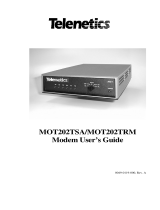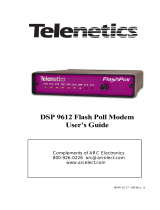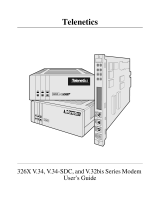Page is loading ...

MOT202TSA/MOT202TRM
Modem User’s Guide
0049-0119-000, Rev. D


The products and programs described in this User’s Guide are licensed
products of Raymar-Telenetics. This User’s Guide contains proprietary
information protected by copyright, and this User’s Guide and all
accompanying hardware and documentation are copyrighted.
Raymar Information Technology, Inc. does not warrant that the
hardware will work properly in all environments and applications, and
makes no warranty and representation, either implied or expressed,
with respect to the quality, performance, merchantability, or fitness for
a particular purpose.
Information in this User’s Guide is subject to change without notice
and does not represent a commitment on the part of Raymar
Information Technology, Inc. Raymar Information Technology, Inc.
assumes no responsibility for any inaccuracies that may be contained in
this User’s Guide.
Raymar Information Technology, Inc. makes no commitment to update
or keep current the information in this User’s Guide, and reserves the
right to make changes to this User’s Guide and/or product without
notice.
No part of this manual may be reproduced or transmitted in any form
or by any means, electronic or mechanical, including photocopying,
recording, or information storage and retrieval systems, for any
purpose other than the purchaser's personal use, without the express
written permission of Raymar Information Technology, Inc.
© Copyright 2008 Raymar Information Technology, Inc.
7325 Roseville Road
Sacramento, California 95842
Tel: 800-695-1951
Direct: (916) 783-1951
Fax: (916) 783-1952


Page iii
Contents
CHAPTER 1 INTRODUCTION........................................................ 5
SUMMARY OF KEY FEATURES ................................................................ 5
MODELS ................................................................................................. 6
USING THIS MANUAL............................................................................. 6
CONTACT INFORMATION ........................................................................ 7
CHAPTER 2 INSTALLING THE MODEM.................................... 9
SITE PREPARATION................................................................................. 9
UNPACKING YOUR HARDWARE.............................................................. 9
ADDITIONAL ITEMS YOU NEED............................................................ 10
HARDWARE OVERVIEW........................................................................ 10
CONFIGURING THE MODEM.................................................................. 11
Jumper S1
−
Carrier Detect Control............................................... 14
Jumper S2
−
Transmit Level............................................................ 14
Jumper S3
−
2-wire/4-wire Mode.................................................... 15
Jumper S4
−
Call Turnaround Squelch........................................... 15
Jumper S5
−
Transmit Carrier ........................................................ 16
Jumper S6
−
Local Copy ................................................................. 16
Jumper S8
−
Signal and Earth Ground........................................... 16
Jumper S9
−
RTS-CTS Delay .......................................................... 17
Jumper S10
−
Carrier Detect Delay................................................ 17
Jumper S11
−
Turnaround Squelch Time........................................ 17
Jumper S12
−
Soft Carrier Turn Off................................................ 18
Jumper S13
−
Anti-Streaming ......................................................... 18
Jumpers S14 and S15
−
Self Test or Test Pattern............................ 19
CONNECTING A DTE ............................................................................ 19
CONNECTING TO A PRIVATE LINE COMMUNICATION CIRCUIT.............. 19
Connecting to an AC Power Source................................................ 19
Powering-on the Modem ................................................................. 20
Powering-off the Modem................................................................. 20

Contents
Page iv
CHAPTER 3 LEDS AND CONTROLS ..........................................21
FRONT PANEL LEDS.............................................................................21
FRONT PANEL TEST SWITCH.................................................................22
CHAPTER 4 TROUBLESHOOTING.............................................25
LOCAL MODEM TEST............................................................................25
LINE AND MODEM TEST .......................................................................26
CHAPTER 5 SPECIFICATIONS....................................................27
GENERAL..............................................................................................27
DIMENSIONS AND WEIGHT ...................................................................28
TEMPERATURE RANGE .........................................................................28
POWER REQUIREMENTS........................................................................28
INTERFACE PIN ASSIGNMENTS..............................................................29
DTE Connector - EIA RS-232-C......................................................29
Telco Connector...............................................................................29
APPENDIX A COMPLIANCES......................................................31
APPENDIX B LIMITED PRODUCT WARRANTY.....................33
APPENDIX C, RMA PROCEDURE...............................................35

Page 5
Chapter 1
Introduction
he Telenetics MOT202TSA standalone modem and
MOT202TRM rack-mount modem are Frequency Shift Keyed
(FSK) modems designed for asynchronous half-duplex
communication on 2-wire private line circuits or full-duplex
communication on 4-wire private-line circuits.
Summary of Key Features
The following list summarizes the modem’s key features.
• Bell 202T compatible.
• Operates over voice-grade leased lines or private lines.
• 0 to 1200 bps operation for unconditioned line.
• 0 to 1800 bps operation for conditioned line (C2).
• Point-to-point or point-to-multipoint polling network.
• 4-wire full-duplex or 2-wire half-duplex leased-line configuration.
• Analog Loopback Test, Digital Loopback Test, Self Test, and Test
Pattern Transmit.
• LED displays for power, RS-232 control, data status, and test
mode.
T

Introduction
Page 6
Models
The Telenetics modem is available in two models:
The MOT202TSA is a desktop modem.
The MOT202TRM is a rack-mount modem that installs into a
standard 19-inch rack.
In this manual, the term “modem” will be used to refer to both models
collectively. If information pertains to one model only, that model will
be identified by its model number.
Using This Manual
This manual contains all the information you need to install, configure,
use, and test your modem.
Chapter 1 contains general information on what the 202T modem
does, contents of this manual, and contact information for
Telenetics.
Chapter 2 describes how to install and configure the modem.
Chapter 3 provides general operating procedures.
Chapter 4 provides troubleshooting procedures.
Chapter 5 lists the modem’s specifications.

Introduction
Page 7
Contact Information
For more information about Telenetics’ MOT202TSA and
MOT202TRM modems, or other Telenetics solutions, please contact us
using any of the following methods.
Voice Calls
We welcome your calls at 800-695-1951 Monday
through Friday, from 7:00 am to 5:00 pm Pacific Time.
Fax Number
You can also send your requests for information to our
24-hour fax number: 916-783-1952.
E-mail
If you prefer, you can send information requests to our
Website
Our website contains valuable information about our
products. We encourage you to visit us online at
www.raymarinc.com.

Introduction
Page 8
NOTES

Page 9
Chapter 2
Installing the Modem
his chapter describes how to install the modem.
Site Preparation
The location where you install your modem should be:
• Within six feet of a 115 or 230 VAC grounded outlet not
controlled by a wall switch
• No more than 50 feet from the data terminal equipment
• Away from extremes of temperature, humidity, and appreciable
shock.
Note: Be sure that there is a 4-inch minimum space at the
back of the modem for signal line and interface cable
clearance.
Unpacking Your Hardware
Your package should include at least one MOT202TSA or
MOT202TRM modem, one RJ-45 jack-to-4 wire leased line cable, and
this Installation Guide. If your package contents are damaged or
missing, please contact your place of purchase immediately.
T

Installing the Modem
Page 10
Additional Items You Need
To use your modem, you need the following additional items:
All users: an RS-232 cable to connect a data terminal. The cable
must conform to the pin assignments shown on page 29.
Standalone modem users: a two- or four-wire transmission line or
leased line and power supply.
Rack-mount modem users: a modem rack with an available slot for
installing the modem.
Hardware Overview
Figures 2-1 and 2-2 show the front and back modem panels of
Standalone.
Figure 2-1 Front Panel

Installing the Modem
Page 11
Figure 2-2. Back Panel
On the front panel of the modem, there are:
One Power LED and six status LEDs (see page 21)
A rotary test switch (see page 22)
On the back panel of the MOT202TSA modem, there are:
A power cord or power input connector
A power switch for turning the modem on and off
A fuse, 3/8 amp, 250 Volt, slow-blow
A DB25 female connector for accommodating a DTE device
An RJ-45 connector for connecting to a communications line
Configuring the Modem
The modem obtains some operating characteristics from jumper
settings. The default jumper settings are for common 4-wire full-duplex
applications. To reconfigure the modem for 2-wire half-duplex and
special applications, you must change the default jumper settings.
To change jumper settings, push the two tabs on the back of the
modem to open the modem cover and gain access to the jumper
settings on the printed circuit board (see Figure 2-3). Then set the
jumpers to the desired settings and replace the cover.
Figure 2-3. Gaining Access to the Modem Jumpers

Installing the Modem
Page 12
Figure 2-4 on the next page shows the location of the modem jumpers.
Table 2-1 on page 13 summarizes the jumper settings (default settings
are bold).
Figure 2-4. Modem Jumper Locations

Installing the Modem
Page 13
Table 2-1. Jumper Settings
Jumper Function Settings See Page…
S1 Carrier Detect control -33 dBm
-43 dBm 14
S2 Transmit level 0dBm
-2 dBm
-4 dBm
-6 dBm
-8 dBm
-10 dBm
-12 dBm
-14 dBm
14
S3 2-wire/4-wire mode 2-wire
4-wire 15
S4 Call turnaround squelch Enabled
Disabled 15
S5 Transmit carrier Control
Constant 16
S6 Local copy Enabled
Disabled 16
S8 Signal and Earth ground Connected
Separate 16
S9 RTS-CTS delay 8 ms
33 ms
59 ms
219 ms
17
S10 Carrier Detect delay 6 ms
23 ms 17
S11 Turnaround squelch time
(Enabled by jumper S4) 8 ms
159 ms 17
S12 Soft Carrier turn off None
8 ms
26 ms
18
S13 Anti-streaming None
4 seconds
7.6 seconds
14 seconds
28 seconds
56 seconds
18
S14 and S15 Self Test or test pattern
(Tx and Rx pattern speed) 1 bps
18 bps
37 bps
75 bps
150 bps
19

Installing the Modem
Page 14
Note: The jumper positions in the following sections reflect the
position of the jumpers on the modem board when you
face the board as indicated in Figure 2-4 on page 12.
Jumper S1
−
Carrier Detect Control
Settings: -33 dBm (default)
-43 dBm
Jumper S1 configures the dynamic range of the modem receiver. The
selections are either –33 dBm or –43 dBm. If the incoming signal is
above –24 dBm, use the default –33 dBm setting. If the modem is
operated on the network, use the –43 dBm setting.
Jumper S2
−
Transmit Level
Settings: 0 dBm (default)
-2 dBm
-4 dBm
-6 dBm
-8 dBm
-10 dBm
-12 dBm
-14 dBm
Jumper S2 adjusts the modem’s transmit level. There are eight transmit
level settings you can choose. By default, the modem uses a transmit
level of 0 dBm.

Installing the Modem
Page 15
Jumper S3
−
2-wire/4-wire Mode
Settings: 2-wire
4-wire (default)
Jumper S3 configures the modem for 2-wire or 4-wire operation.
When configured for 4-wire full-duplex operation, jumper S5 can
be strapped to maintain constant carrier from the master modem to
all slave modems at all times after the initial training. This enables
the master modem to transmit data to the slave modems, with no
RTS-to-CTS delay. This is the preferred operating mode when
minimum turnaround is desired.
When configured for 2-wire half-duplex operation, the modem
encounters an RTS-to-CTS delay when transmitting to slave
modems, increasing the turnaround time. Set jumper S5 to
controlled carrier for 2-wire half-duplex operation.
Jumper S4
−
Call Turnaround Squelch
Settings: Enabled
Disabled (default)
Jumper S4 configures the modem’s Call Turnaround Squelch setting.
For 2-wire, half-duplex communications, set this strap to the Enabled
position. In this position, the receiver is inhibited for a period of time
after the local transmitter is turned OFF. This guards against echoes
caused by the transmission just completed. The time is determined by
the turnaround squelch time option (jumper S11).
For 4-wire, full-duplex communications, keep the jumper set to the
default position of Disabled.

Installing the Modem
Page 16
Jumper S5
−
Transmit Carrier
Settings: Control (default)
Constant
Jumper S5 places the transmitter under terminal control (default) or
turns on the transmitter continuously in a 2-wire half duplex system.
Jumper S6
−
Local Copy
Settings: Enabled
Disabled (default)
Jumper S6 must be left in the default position of Disabled when
operating on a 4-wire network. It is also normally left in the default
Disabled position when operating on a 2-wire network. Strapping this
jumper as Disabled inhibits the local receiver from receiving the
transmission of the local transmitter.
Jumper S8
−
Signal and Earth Ground
Settings: Connected
Separate (default)
Jumper S8 allows Earth GND to be tied to the modem system GND.

Installing the Modem
Page 17
Jumper S9
−
RTS-CTS Delay
Settings: 8 ms (default)
33 ms
59 ms
219 ms
Jumper S9 configures the modem’s RTS-CTS delay. Four choices for
selecting an RTS-CTS delay are available.
Jumper S10
−
Carrier Detect Delay
Settings: 6 ms (default)
23 ms
Jumper S10 configures the modem’s Carrier Detect turn on Delay
timing. The delay chosen must be consistent with the Clear To Send
delay selection of the transmitting modem and must be less than the
CTS delay. The available delays are 6 ms (default) and 23 ms. The
carrier detect drop out is less than 6 ms.
Jumper S11
−
Turnaround Squelch Time
Settings: 8 ms (default)
159 ms
Jumper S11 is used with the call turnaround squelch option (jumper
S4). The available times are 8 ms (default) and 159 ms.

Installing the Modem
Page 18
Jumper S12
−
Soft Carrier Turn Off
Settings: None
8 ms (default)
26 ms
Jumper S12 configures the modem to either turn off the transmitter
immediately upon release of Request To Send, or send a Soft Carrier
Turn Off signal of 900 Hz for 8 or 26 ms at the end of each
transmission.
Jumper S13
−
Anti-Streaming
Settings: None (default)
4 seconds
7.6 seconds
14 seconds
28 seconds
56 seconds
Jumper S13 lets you select an anti-streaming time or use no anti-
streaming at all. Anti-streaming is typically used in multi-point
applications to prevent a malfunctioning slave from occupying the line
indefinitely.
When anti-streaming is active, the modem can only transmit data for up
to 56 seconds. Thereafter, the modem’s transmitter is automatically
turned off. The modem then looks for an ON-to-OFF transition of
Request To Send (RTS) before proceeding with normal operation.
/








